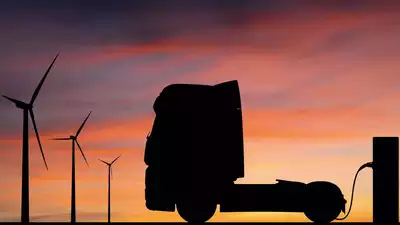
This article is authored by Anirudh Bhuwalka, CEO, Blue Energy Motors.
India, with its burgeoning population and rapidly expanding urbanization, faces a pressing need to address environmental concerns and reduce its carbon footprint – specifically in transportation sector where the number of trucks required will quadruple by 2050. Since COP28 aimed at addressing the critical intersection between climate change and global health, emphasis is on the need for swift and substantial reductions in greenhouse gas emissions to meet the zero emissions target by 2070.
As the country strives towards sustainable development, the spotlight on transitioning the transportation sector to clean energy has intensified. Thus, there is a clarion call for a switch to use cleaner fuels in the transportation and logistics sector.
Switching to Clean Trucking
With the rapid growth in demand for road freight, decarbonisation of the heavy trucking segment has become even more important. In India, the medium- and heavy-duty trucking sector constitutes a mere 4% of the total vehicle population. Yet, it is responsible for 40% of the overall road transportation emissions — surpassing other vehicle segments primarily because of elevated fuel consumption. India has already realized the impact of logistics on its carbon footprint and is thus undertaking endeavours to transform the logistics landscape to achieve clean trucking. The government is emphasizing on decarbonization of the transportation sector by facilitating adoption of eco-friendly modes such as LNG trucks, electric vehicles, flexible-fuel vehicles and hydrogen-powered fuel cell electric vehicles (FCEVs).
From the long haul transportation perspective: LNG (liquefied natural gas) is a cleaner-burning fuel that produces lower emissions compared to diesel, making it an attractive option for reducing the environmental impact. LNG trucks present a compelling alternative for heavy duty long-haul transportation, with superior Total Cost of Ownership (TCO) and range coupled with unmatched reliability. Designed with an successful natural gas engine, delivering impressive torque and horsepower, these trucks prioritize fuel efficiency and quieter operations compared to diesel engines. Since the fuel is available in the condense the form and these trucks feature a suitable cryogenic fuel tank, they cover significant distances of over 1000 kms on a single fill, alleviating range anxiety concerns. The integration of advanced telematics systems ensures secure journeys, while the expanding LNG dispensing network promises comprehensive coverage across major routes, reducing the need for frequent refills. In summary, LNG trucks redefine efficiency and sustainability in the realm of long-haul transportation.
For the short hauls: Advancements in battery technology, particularly cost reductions, and increased energy density, now make it possible to electrify trucks, a prospect once deemed remote. When widely implemented, battery electric trucks can offer a lower total cost of ownership compared to diesel counterparts in various weight categories. Additionally, electric trucks powered by renewable and domestically produced energy can replace diesel trucks. In addition to economic benefits, the transition to battery electric trucks promises improved environmental advantages, with potential greenhouse gas intensity reductions ranging from 9% to 35% across different truck classes compared to diesel, considering India’s current average grid emissions intensity.
How Large Corporations are Leading the Change
The shift to near zero-emission trucks in India necessitates proactive involvement from consumers, investors, and corporate entities. Businesses in India aiming to reduce indirect emissions are capitalizing on freight electrification, particularly in key trucking segments like parcels and consumer goods deliveries (approximately 45% of trucks) and perishables (about 18%). Major freight users, particularly those utilizing third-party logistics providers, have the influence to drive the transition to electric trucks.
Recognizing the importance of sustainability, India’s Fortune 500 companies such as CONCOR, Dalmia Cement, JSW Steel, JK Laxmi Cement, UltraTech Cement, Tata Steel, Reliance, Nestle, among others, are already leading the charge by embracing LNG trucks for their inbound logistics and raw material movement. Hence, these industry leaders are making significant strides in adopting cleaner and more efficient transportation options.
Original equipment manufacturers (OEMs) are collaborating with international leaders in alternate fuel green trucks to accelerate the progress and production of diverse green truck models. The swift development of ecosystem infrastructure, including supply and service networks, LNG pumps, charging points, etc. holds paramount significance for transporters considering the transition to green trucks. Notably, key industry players such as Oil Marketing Companies (OMCs), GAIL, its subsidiaries, and Bharat Liquefied Natural Gas (BLNG) are actively establishing 50-70 LNG retail outlets nationwide, out of which currently only 9 are functional. Similar initiatives have also been taken for establishing charging infrastructure for EV vehicles. These initiatives are also seeking governmental support to facilitate the rapid transition to cleaner fuels.
The Way Forward
Strategic partnerships across the supply chain are vital for a sustainable future in India’s trucking industry. The collective efforts of government, truck manufacturers and alternate fuel providers as battery manufacturers, & oil marketing companies, key corporates and their fleet operators, and charging infrastructure providers will be instrumental in establishing a thriving market for clean trucks. Strengthening these collaborations can catalyse the widespread deployment of green trucks throughout the country. As India embarks on its journey toward decarbonization, the success of our efforts in embracing clean trucking hinges on collaborative efforts and a shared commitment to innovation and sustainability. By fostering partnerships and encouraging increased public-private cooperation, we will adhere to the COP26 commitment and pave the way for a greener, healthier, and more prosperous future for us.
